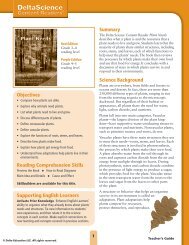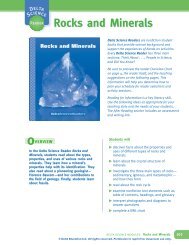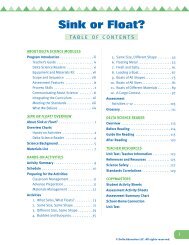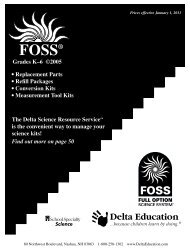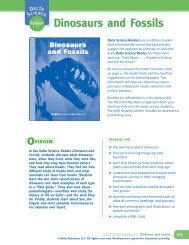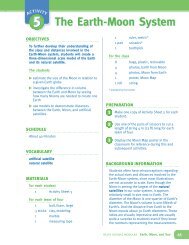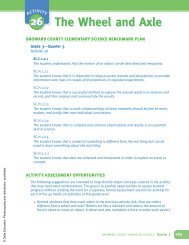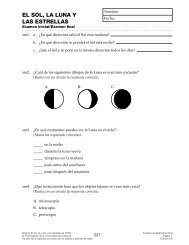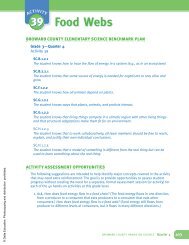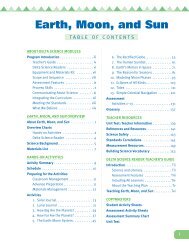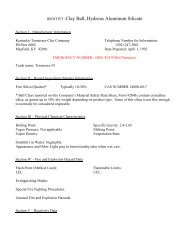Cells and Classification - Delta Education
Cells and Classification - Delta Education
Cells and Classification - Delta Education
Create successful ePaper yourself
Turn your PDF publications into a flip-book with our unique Google optimized e-Paper software.
<strong>Cells</strong> <strong>and</strong><br />
<strong>Classification</strong><br />
Contents<br />
Preview the Book . . . . . . . . . . . . . . . . . . . . . . . . . . . 2<br />
What Are Living Things? . . . . . . . . . . . . . . . . . . 3<br />
Features of Living Things . . . . . . . . . . . . . . . . . 4<br />
Compare <strong>and</strong> Contrast . . . . . . . . . . . . . . . . . . . . . . . . 6<br />
What Are <strong>Cells</strong>? . . . . . . . . . . . . . . . . . . . . . . . . . . 7<br />
<strong>Cells</strong> <strong>and</strong> Their Functions . . . . . . . . . . . . . . . . . 8<br />
Plant <strong>and</strong> Animal <strong>Cells</strong> . . . . . . . . . . . . . . . . . . 10<br />
How to Read Charts . . . . . . . . . . . . . . . . . . . . . . . . . 12<br />
How Are Living Things Classified? . . . . . . . . . 13<br />
Classifying Organisms . . . . . . . . . . . . . . . . . . . 14<br />
Animal Kingdom . . . . . . . . . . . . . . . . . . . . . . . 16<br />
Plant Kingdom . . . . . . . . . . . . . . . . . . . . . . . . . 17<br />
Other Kingdoms of Life . . . . . . . . . . . . . . . . . . 18<br />
Levels of <strong>Classification</strong> . . . . . . . . . . . . . . . . . . . 19<br />
Main Idea <strong>and</strong> Details . . . . . . . . . . . . . . . . . . . . . . . 20<br />
What Can We Learn From Fossils? . . . . . . . . . 21<br />
About Fossils . . . . . . . . . . . . . . . . . . . . . . . . . . 22<br />
Glossary . . . . . . . . . . . . . . . . . . . . . . . . . . . . . . . . 24<br />
© <strong>Delta</strong> <strong>Education</strong> LLC. All rights reserved.
Glossary<br />
bacteria (bak-TIR-ee-uh) tiny organisms<br />
made of one cell with no nucleus; singular:<br />
bacterium (18)<br />
cell (SEL) the basic unit of all living things (8)<br />
cell membrane (SEL MEM-brayn) the thin<br />
covering that surrounds <strong>and</strong> protects a cell’s<br />
cytoplasm (10)<br />
cell wall (SEL WAHL) the outer layer of a<br />
plant cell (10)<br />
chlorophyll (KLOR-uh-fil) the green material<br />
in plant cells that takes in light energy from<br />
the Sun for use in making food (17)<br />
chloroplast (KLOR-uh-plast) the part of a<br />
plant cell where food is made (10)<br />
classify (KLAS-uh-fye) to group together<br />
things that are alike (14)<br />
cytoplasm (SYE-toh-plaz-uhm) the jelly-like<br />
material that fills a cell <strong>and</strong> that holds the<br />
nucleus <strong>and</strong> other cell parts (10)<br />
environment (en-VYE-ruhn-muhnt) all the<br />
physical things <strong>and</strong> conditions, such as soil,<br />
air, water, plants, animals, <strong>and</strong> weather, that<br />
surround a living thing (4)<br />
extinct (ek-STINKT) no longer living as a<br />
species (22)<br />
fossil (FOS-uhl) the preserved remains or<br />
traces of an organism that lived long ago (22)<br />
fungus (FUHNG-uhs) an organism that<br />
absorbs food, usually from dead organisms;<br />
plural: fungi (18)<br />
invertebrate (in-VUR-tuh-brit) an animal<br />
that does not have a backbone (16)<br />
kingdom (KING-duhm) one of the six large<br />
groups of living things; animals, plants, fungi,<br />
protists, true bacteria, <strong>and</strong> ancient bacteria (14)<br />
24<br />
microscope (MYE-kruh-skohp) a tool that<br />
makes a tiny object look bigger (8)<br />
nonvascular (non-VAS-kyuh-lur) not having<br />
tubes for moving water <strong>and</strong> food to the parts<br />
of a plant (17)<br />
nucleus (NOO-klee-uhs) the part of a cell<br />
that controls the cell’s activities (10)<br />
organ (OR-guhn) a group of tissues that work<br />
together to do a job (9)<br />
organism (OR-guh-niz-uhm) a living thing,<br />
such as a plant, an animal, or a fungus (4)<br />
organ system (OR-guhn SIS-tuhm) a group<br />
of organs that work together to do a job for an<br />
organism (9)<br />
phylum (FYE-luhm) the level of classification<br />
of living things below kingdom; plural: phyla<br />
(19)<br />
protist (PROH-tist) a tiny organism, most<br />
of which are made of one cell with a nucleus<br />
(18)<br />
reproduce (ree-pruh-DOOS) to make more<br />
of one’s own kind (5)<br />
species (SPEE-sheez) a group made up of all<br />
the living things of the same kind (19)<br />
tissue (TISH-oo) a group of the same kind of<br />
cells that work together to do a job (9)<br />
trait (TRAYT) a feature that can be used to<br />
classify an organism (14)<br />
vascular (VAS-kyuh-lur) having tubes that<br />
move water <strong>and</strong> food to the parts of a plant<br />
(17)<br />
vertebrate (VUR-tuh-brit) an animal that<br />
has a backbone (16)<br />
© <strong>Delta</strong> <strong>Education</strong> LLC. All rights reserved.



